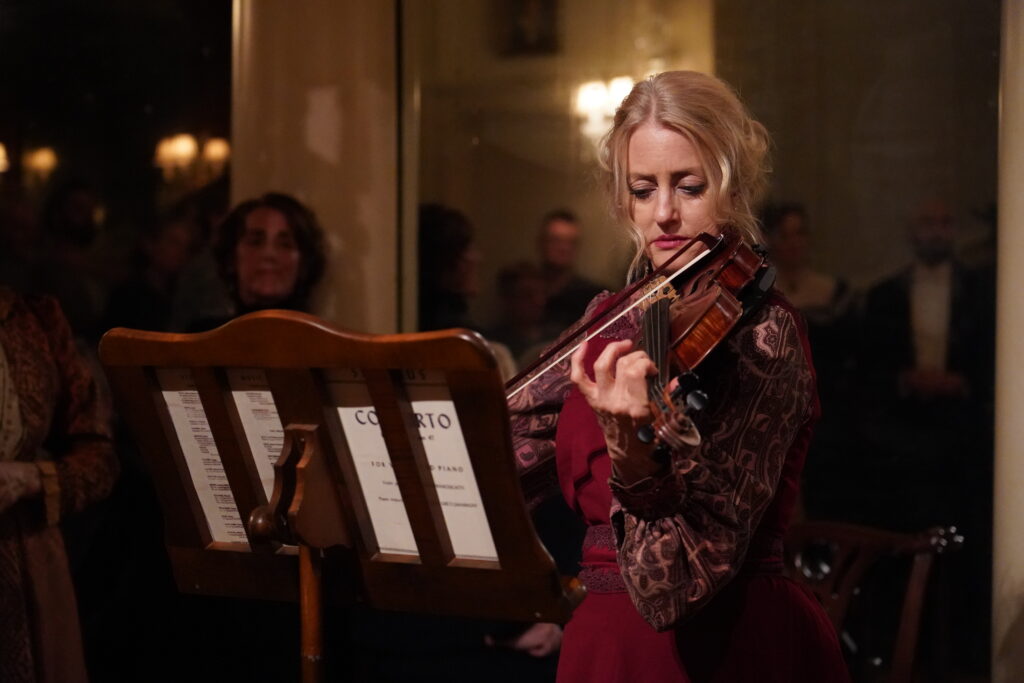Having Dinner With James Joyce on Fifth Avenue — And in a Mansion, To Boot
For New Yorkers looking to encounter the master close to home, there is an immersive play, ‘The Dead, 1904,’ a stone’s throw from the Metropolitan Museum of Art.

“The Dead” is the last story in James Joyce’s collection “Dubliners.” It is one of the great short tales of the 20th century. The Irish author wrote it before he would, with “Ulysses” and “Finnegan’s Wake,” remake the novel. It is the perfect entry point for readers seeking to meet the master on more forgiving terrain. For New Yorkers looking to encounter Joyce, there is an immersive play, “The Dead, 1904” — opening tonight — on Fifth Avenue.
The setting is the sumptuous American-Irish historical society, a Beaux-Art townhouse across the street from the Metropolitan Museum of Art. The production, which recreates the Feast of the Epiphany that is the occasion for “The Dead,” was first staged in 2016 and ran until the pandemic hit. The producer, Nina Korelitz Matza, told me over a slug of port that Chief Justice Roberts has attended. The show, adapted by the Irish poet Paul Mudoon and the novelist Jean Hanff Korelitz along with the Irish Repertory Theater and Dot Dot Productions, is back.
The Sun had an email exchange with Mr. Muldoon, a Pulitzer Prize winner and longtime poetry editor at the New Yorker who, along with Jean Hanff Korelitz, worked Joyce’s story into shape for the stage. Mr. Muldoon ventures that it “takes a certain amount of nerve, I know, to try to out-Joyce Joyce. However, I did feel that our immersive stage version would benefit from a few clarifications and have tried to introduce those as nimbly and nuancedly as possible.”
Completing the reading ahead of time is not required, but it is recommended. “The Dead” unfolds at a Dublin townhouse rented by two aged sisters with refined musical tastes, Kate and Julia Morkan — and their niece Mary Jane. They host an annual party, and the guest of honor is their nephew, Gabriel Conroy. He brings his wife Gretta. Joyce’s sure hand sketches a range of supporting characters with verve. The mood is warmth spiced with intimations of loss.
Joyce is interested in human detail and Ireland’s destiny. Readers can smell the alcohol on the breath of one character, Freddy Malin, but also the slight turbulence caused by the presence of a Protestant, Mr. Browne. Then there is Irish patriot Molly Ivors, who castigates Conroy for writing literary reviews for a paper less committed to the cause. The Easter Rising of 1916 is in the future, but its stirrings are as tangible as the sliced goose served for supper.

The bottom falls out from “The Dead” when a song sung at dinner — “The Lass of Aughrim” — lingers with Greta after the Conroys return to their hotel. All of a sudden holiday cheer gives way to an almost unbearably poignant memory of childhood love and loss. The song is to Greta what the madeleine is to Proust, but what it brings back is a long-dead boy, Michael Furey, buried in County Galway, another world from Dublin’s districts.
Joyce ends with “the snow falling faintly through the universe and faintly falling, like the descent of their last end, upon all the living and the dead.” Any sense, though, that “The Dead, 1904” will be a downer is dispelled once the viewer is greeted by actors playing the roles from Joyce’s story. Irish worthies gaze down from oil paintings on the wall, and before long flutes of champagne have found their way between the attendees’ fingers. The party is about to begin.
This correspondent had a chat with Mr. Browne, who, without missing a beat, wondered over the wisdom of inviting a critic with a notebook to a holiday party. The show, from Dot Dot productions and the Irish Repertory Theater, is directed by Ciarán O’Reilly with a sure hand. The audience is brought in close, and the actors convincingly project what Joyce in the story calls “the tradition of genuine warm-hearted courteous Irish hospitality. “
That tradition is upheld — ticket prices range up to $1,000* — for the entirety of the two-hour production. The meal, taken with strangers and the cast, is hearty and redolent of Sunday roasts and protracted pub evenings. A mention of the harrowing ravages of the Famine at the town of Gort, which would have been a memory for some of Joyce’s protagonists, adds a somber note of hunger’s haunting.
The audience takes the stairs up for the play’s last scene, and Greta’s recall of Michael Furey puts into sharp relief the merriment that preceded it. The scene’s finale, like the story’s, adds gravity, the force that pulls down not only snow from the sky but also tears from the eyes. Joyce writes that “snow was general all over Ireland. It was falling on every part … softly falling into the dark mutinous Shannon wave.” Not yet, but soon, at Co. New York.
________
* Aye, but cheap at the price.

